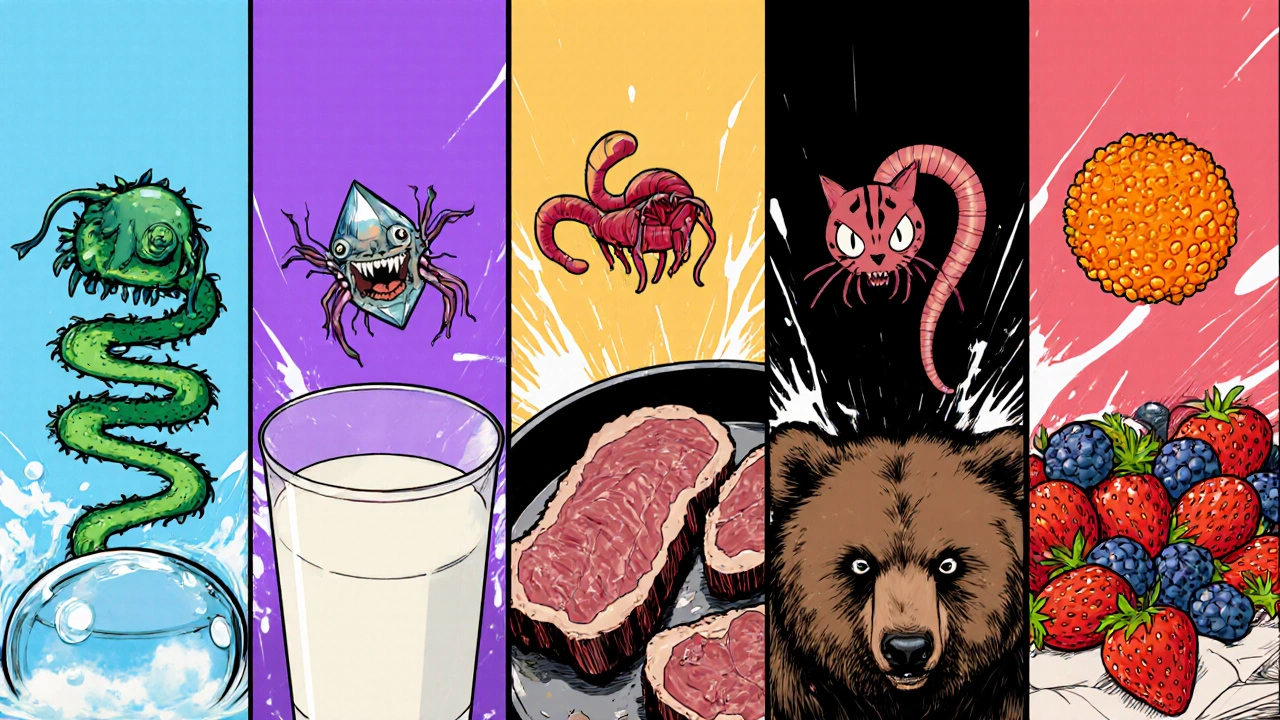Food Safety Risk Assessment Tool
Answer the following questions about your food handling practices to determine your risk of parasitic foodborne illness.
Your Food Safety Risk Assessment
Risk Level Explained
Low risk (0-3): Minimal risk of parasitic infection with proper food handling.
Medium risk (4-7): Moderate risk - consider improving food safety practices.
High risk (8-8): Significant risk - take immediate action to improve food safety.
Personalized Recommendations
When you hear "food poisoning," bacteria usually get the blame. But a hidden group of culprits-parasitic infections-are responsible for a surprisingly large share of foodborne illness worldwide.
Parasitic infections are diseases caused by organisms that live on or inside a host, drawing nutrients and often causing damage. Commonly, these parasites hitch a ride on contaminated food or water, turning a simple meal into a health hazard. Understanding how they move from farm to fork helps you protect yourself and your family.
Key Takeaways
- Parasites cause 30‑40% of global foodborne disease outbreaks.
- Giardia, Cryptosporidium, Toxoplasma, Trichinella and Cyclospora are the top offenders.
- Improper cooking, unfiltered water and cross‑contamination are the main transmission routes.
- Symptoms range from mild stomach upset to severe dehydration and organ damage.
- Simple food‑safety steps-proper washing, cooking, and storage-cut the risk dramatically.
How Parasites Slip Into Our Food
Unlike bacteria that grow fast at room temperature, parasites usually need a specific host or environment to mature. The most common ways they end up on our plates are:
- Contaminated water: Freshwater sources can harbor cysts or oocysts that survive for months.
- Undercooked meat: Certain parasites form cysts in muscle tissue that only die at higher temperatures.
- Fresh produce: Leafy greens and berries can pick up parasites from irrigation water or soil.
- Cross‑contamination: Cutting boards, knives, or hands that touch raw infected foods can spread parasites to ready‑to‑eat items.
Top Parasites Behind Foodborne Outbreaks
| Parasite | Typical Food Source | Incubation (days) | Main Symptoms | Prevention Tips |
|---|---|---|---|---|
| Giardia lamblia is a flagellated protozoan that lives in the intestines of humans and animals. | Unfiltered water, raw vegetables irrigated with contaminated water. | 1‑2 | Watery diarrhea, abdominal cramps, nausea. | Boil water >1 min; wash produce with safe water. |
| Cryptosporidium is a tiny protozoan that forms hardy oocysts. | Recreational water, untreated milk, fresh produce. | 2‑10 | Profuse watery diarrhea, fever, weight loss. | Avoid drinking untreated water; refrigerate milk promptly. |
| Toxoplasma gondii is an intracellular protozoan that reproduces in cats. | Undercooked pork, lamb, contaminated fruit. | 5‑23 | Flu‑like symptoms, swollen lymph nodes; severe in pregnant women. | Cook meat to 67 °C (152 °F); wash fruit thoroughly. |
| Trichinella spiralis is a nematode larva that encysts in muscle tissue. | Undercooked pork, wild boar, bear meat. | 7‑55 | Muscle pain, fever, nausea, swelling around eyes. | Heat meat to 71 °C (160 °F) internally. |
| Cyclospora cayetanensis is a coccidian parasite that requires time to become infectious after shedding. | Berries, lettuce, herbs from tropical regions. | 7‑14 | Persistent watery diarrhea, fatigue, weight loss. | Wash produce with safe water; avoid raw produce from questionable sources. |

Symptoms, Diagnosis, and Treatment
The clinical picture often overlaps with bacterial food poisoning, making lab testing essential. Doctors typically request stool examinations, antigen tests, or PCR assays to pinpoint the parasite.
Once identified, treatment varies:
- Giardia: Metronidazole or tinidazole for 5‑7 days.
- Cryptosporidium: Nitazoxanide for immunocompetent patients; hydration is critical.
- Toxoplasma: Pyrimethamine + sulfadiazine for severe cases, especially in pregnancy.
- Trichinella: Albendazole or mebendazole; severe muscle inflammation may need steroids.
- Cyclospora: Trimethoprim‑sulfamethoxazole (TMP‑SMX) for 7‑10 days.
Hydration, electrolyte replacement, and rest remain universal supportive measures.
Preventing Parasite‑Related Foodborne Illness
Public health agencies such as the CDC (Centers for Disease Control and Prevention) and the WHO (World Health Organization) publish clear guidelines. Follow these core practices:
- Water safety: Boil, filter, or treat water that isn’t from a verified municipal source.
- Cook meat thoroughly: Use a food thermometer; pork and wild game should reach at least 71 °C.
- Wash produce correctly: Rinse under running water; consider a vinegar‑water soak for leafy greens.
- Avoid cross‑contamination: Separate cutting boards for raw meat and vegetables; sanitize surfaces after each use.
- Stay updated on recalls: Agencies post alerts when contaminated batches of produce or meat are identified.

Quick Checklist for Home Kitchens
- Boil water for 1 minute before drinking or cooking.
- Use a thermometer; pork, lamb, and wild game ≥71 °C.
- Wash fruits/veg with safe water; scrub tough skins.
- Keep raw meat separate from ready‑to‑eat foods.
- Replace cutting boards regularly; use non‑porous surfaces.
Public Health Monitoring and Outbreak Response
Surveillance systems track parasite‑related outbreaks through laboratory reporting and case interviews. In the United States, the CDC maintains a Foodborne Disease Outbreak Surveillance System (FDOSS) that logs each incident, identifies the source, and informs recall actions.
Internationally, the WHO coordinates the Global Outbreak Alert and Response Network (GOARN), ensuring rapid information exchange between countries. Data from these bodies help shape food‑safety regulations, such as mandatory testing of irrigation water in high‑risk regions.
Can I get a parasitic infection from canned food?
Canned foods that are properly processed at high temperatures are generally safe. If the can is damaged, bulging, or improperly sealed, it could harbor spores, but parasites are rare in canned goods.
Is washing produce with soap effective against parasites?
Soap residues can remain on edible parts and may cause irritation. A thorough rinse with safe water, possibly followed by a mild vinegar solution, is recommended.
How long do parasite cysts survive on kitchen surfaces?
Cysts of Giardia and Cryptosporidium can survive weeks on moist surfaces. Regular disinfection with bleach (1 % solution) or EPA‑approved sanitizers kills them.
Are frozen fruits safe regarding Cyclospora?
Freezing does not reliably inactivate Cyclospora oocysts. Cooking or a thorough wash with safe water is required.
What should I do if I suspect a parasite infection after a meal?
Seek medical care promptly. Provide details about recent foods, travel, and water sources. Early stool testing improves treatment success.





Penny Reeves
October 19, 2025 AT 12:53Another article trying to sound scientific while ignoring basic kitchen hygiene.
Christopher Burczyk
October 21, 2025 AT 00:40While the overview is informative, it overlooks the pivotal role of robust public health surveillance in differentiating parasitic from bacterial etiologies. The reliance on stool PCR without discussing its sensitivity thresholds may mislead clinicians. Additionally, the recommendation to "use a thermometer" fails to specify calibration standards required for accurate parasite inactivation. A more nuanced discussion of the epidemiological trends across various socioeconomic strata would have strengthened the piece. The omission of zoonotic pathways, particularly in the context of emerging wildlife markets, is a glaring gap.
Nicole Boyle
October 22, 2025 AT 18:20One of the most fascinating aspects of foodborne parasitology is the interplay between oocyst resilience and supply-chain logistics. The cystic forms of Giardia and Cryptosporidium possess remarkably low metabolic rates, allowing them to persist on moist surfaces for weeks, which fundamentally alters risk assessments for kitchen sanitation protocols. Moreover, the thermodynamic thresholds required to denature Toxoplasma gondii tissue cysts (approximately 67 °C) intersect with contemporary sous‑vide practices, posing a subtle yet significant hazard when temperature validation is lax.
From a molecular standpoint, the surface glycoproteins of Cyclospora spp. confer an unusual resistance to standard chlorination, necessitating alternative disinfection modalities such as peracetic acid. In contrast, Trichinella spiralis larval encystation is highly dependent on host muscle pH, a factor that can be manipulated through marination techniques, albeit with limited efficacy.
The epidemiological data indicating that 30‑40 % of global outbreaks involve parasites underscores a systemic underreporting bias, largely attributable to the limited accessibility of multiplex PCR panels in low‑resource settings. This creates a feedback loop where clinical suspicion remains low, perpetuating diagnostic inertia.
Practically, cross‑contamination vectors are often overlooked in standard operating procedures. For instance, porous wooden cutting boards can harbor micro‑crevices that protect cysts from surface sanitizers, a fact that is seldom emphasized in culinary training curricula.
Finally, the socioeconomic determinants of parasitic infection risk cannot be divorced from water infrastructure quality. In regions where untreated surface water is a staple, the baseline exposure risk dwarfs that of even the most stringent kitchen hygiene measures. Therefore, public health interventions must adopt a multifaceted approach that integrates water safety, food handling, and community education to mitigate this pervasive threat.
Caroline Keller
October 24, 2025 AT 12:00It is infuriating how often we turn a blind eye to the invisible suffering caused by these microscopic invaders
dennis turcios
October 26, 2025 AT 18:33The post does a decent job outlining basic prevention steps, yet it skirts around the economic realities that limit access to proper water filtration in many communities. While advocating for boiling water, it fails to acknowledge the fuel constraints faced by low‑income households, which can inadvertently push them toward unsafe alternatives. Also, the suggestion to "use a thermometer" overlooks the fact that many home cooks lack calibrated devices, rendering the advice less actionable. A more balanced perspective would incorporate low‑cost strategies, such as solar disinfection or community‑level water testing initiatives.
Felix Chan
October 29, 2025 AT 02:06Great rundown! Remember, a little extra care in the kitchen goes a long way toward keeping everyone safe and healthy.
Thokchom Imosana
October 31, 2025 AT 09:40What most people don't realize is that the very agencies promoting these "simple" food‑safety guidelines are often under the covert influence of agribusiness conglomerates that profit from keeping the public clueless about the true scale of parasitic contamination. The narrative about "boil water for one minute" is deliberately vague, because if you dig deeper you discover that the recommended duration is calibrated to a specific brand of industrial sterilizer, not the average household kettle. Moreover, the push for centralized processing plants creates massive bottlenecks where a single lapse can seed an outbreak affecting millions, yet the media remains silent, focusing instead on sensationalist stories about viral pandemics. This selective attention serves to distract from the systematic negligence that allows parasites to proliferate in our food supply.
ashanti barrett
November 2, 2025 AT 17:13I appreciate the thoroughness of the guide and will definitely implement the extra washing steps for leafy greens before serving guests.
Maridel Frey
November 5, 2025 AT 00:46Thank you for sharing such a comprehensive checklist. It’s important that we all adopt these evidence‑based practices to safeguard public health, especially in community kitchens and during large gatherings.
Monika Bozkurt
November 7, 2025 AT 08:20In the grand tapestry of food safety, each preventive measure represents a thread that, when woven together, creates a resilient fabric against parasitic threats. Embracing these practices not only protects individual health but also reinforces collective responsibility, fostering a culture of vigilance and compassion.
Bobby Marie
November 9, 2025 AT 15:53Watch your produce.